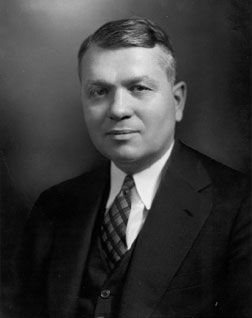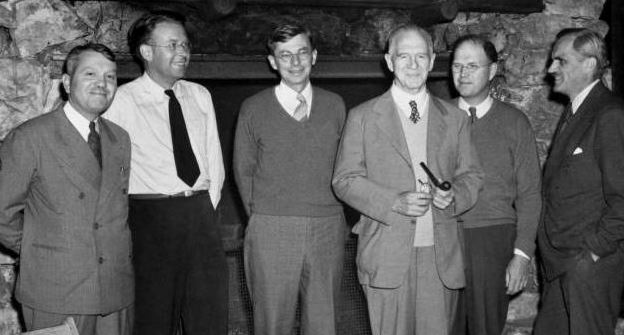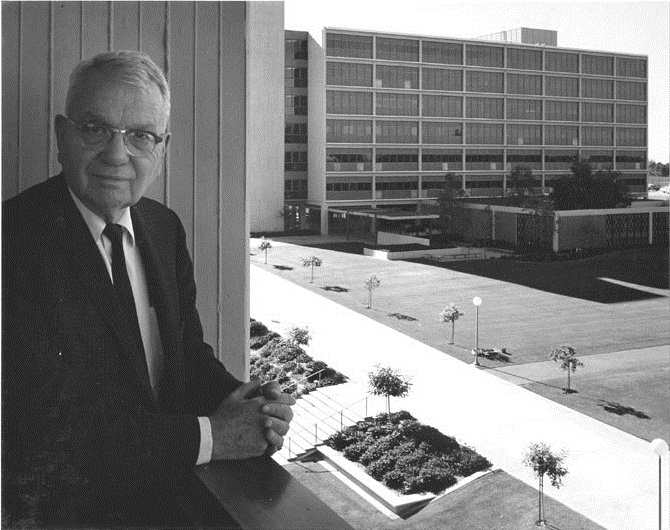<Back to Index>
- Chemist Harold Clayton Urey, 1893
PAGE SPONSOR
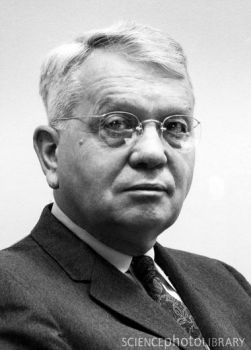
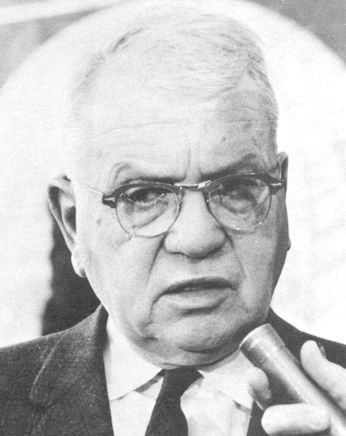
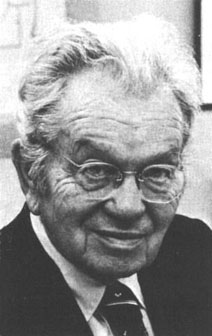
Harold Clayton Urey (April 29, 1893 – January 5, 1981) was an American physical chemist whose pioneering work on isotopes earned him the Nobel Prize in Chemistry in 1934. He played a significant role in the development of the atom bomb, but may be most prominent for his contribution to theories on the development of organic life from non - living matter.
Urey was born in Walkerton, Indiana, to Reverend Samuel Clayton Urey and Cora Rebecca Reinoehl. After briefly teaching in rural schools, Urey earned a degree in zoology from the University of Montana and a Ph.D. in chemistry, studying thermodynamics under Gilbert N. Lewis at the University of California at Berkeley.
At Berkeley, Urey was influenced by the work of physicist Raymond T. Birge and soon joined Niels Bohr in Copenhagen to work on atomic structure at the Institute for Theoretical Physics. On his return to the U.S. and between 1924 and 1928, he taught at The Johns Hopkins University as 'Associate in Chemistry', and then at Columbia where he assembled a team of associates that included Rudolph Schoenheimer, David Rittenberg and T.I. Taylor. After completion of his text with Arthur Ruark, Atoms, Quanta and Molecules, one of the first English texts on quantum mechanics and its applications to atomic and molecular systems, Urey became interested in nuclear systematics. This led to his discovery of deuterium.
During this time, Urey isolated deuterium by repeatedly distilling a sample of liquid hydrogen. In 1931, he and his associates went on to demonstrate the existence of heavy water. Urey was awarded the Nobel Prize in Chemistry in 1934 for this work.
During World War II, Urey's team at Columbia worked on a number of research programs that contributed towards the Manhattan Project to develop an atomic bomb for the United States. Most importantly, they developed the gaseous diffusion method to separate uranium - 235 from uranium - 238. In autumn 1941, Urey, with G.B. Pegram, led a diplomatic mission to England to establish co-operation on development of the atomic bomb.
Isaac Asimov, a student at Columbia at this time, remembers Urey lamenting, perhaps too vehemently, how pained he was that he could do nothing to help the war effort. Asimov pointed out innocently that perhaps the enriched uranium kept at Columbia may have had something to do with the war effort. Urey reddened and changed the subject. He had worried about the German atomic bomb while working on uranium separation at Columbia during the war, was now referring to the most dangerous situation that humanity has ever faced in all history.
After the war, Urey became professor of chemistry at the Institute for Nuclear Studies, then Ryerson professor of chemistry at the University of Chicago before progressing to honorific offices at the University of California, San Diego. A UCSD building was named in his honor in the early 1960s, during a time when nearly all buildings other than student dormitories had only generic names. The name of the building is actually the "Frieda and Harold Urey Hall". Urey would have rejected the honor, he hated the architecture of the building, but since it also honored his wife he accepted.
In later life, Urey helped develop the field of cosmochemistry and is credited with coining the term. His work on oxygen - 18 led him to develop theories about the abundance of the chemical elements on earth and of their abundance and evolution in the stars. This work was among the pioneering paleoclimatic research. Urey summarised his work in the book The Planets: Their Origin and Development (1952). Urey speculated that the early terrestrial atmosphere was probably composed of ammonia, methane and hydrogen; it was one of his Chicago graduate students, Stanley L. Miller, who showed that, if such a mixture be exposed to electric sparks and to water, it can interact to produce amino acids, commonly called the "building blocks of life" (Miller-Urey experiment).
Urey died at La Jolla, California, and is buried in the Fairfield Cemetery in DeKalb County, Indiana. While working at Columbia University, Urey was a resident of Leonia, New Jersey.
Apart from his Nobel Prize, he also won the J. Lawrence Smith Medal in 1962, the Gold Medal of the Royal Astronomical Society in 1966, and the Priestley Medal of the American Chemical Society in 1973. In 1964 he received the National Medal of Science. Named after him are lunar impact crater Urey, asteroid 4716 Urey and the H.C. Urey Prize, awarded for achievement in planetary sciences by the American Astronomical Society.
The Harold C. Urey Middle School in Walkerton, Indiana, is also named
for him, as is Urey Hall, the chemistry building at Revelle College,
UCSD, in La Jolla, California. (The actual name of the building is
"Freida and Harold Urey Hall" because the naming committee worried that
Dr. Urey might reject the honor, but knew he could not decline an honor
to his wife.) UCSD has also established a Harold C. Urey chair whose first holder is Dr. James R. Arnold. Urey Lecture Hall on the University of Montana campus in Missoula, Montana, also bears his name.
